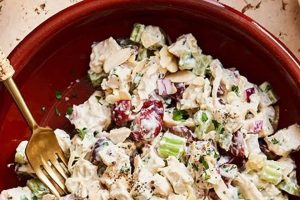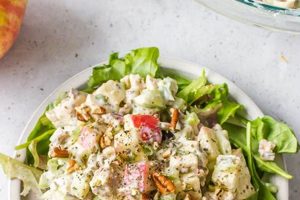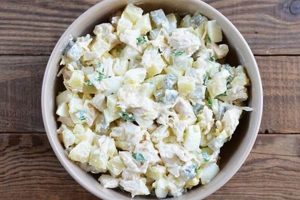A dish combining elements of classic tacos with the presentation of a salad, this culinary creation typically features seasoned ground or shredded chicken, crisp lettuce, tomatoes, onions, cheese, and often other ingredients such as corn, black beans, or avocado. The salad is often served with tortilla chips, either crushed and mixed in or served alongside for scooping, and topped with a creamy dressing, frequently ranch-style or a cilantro-lime vinaigrette. Variations can include different proteins, vegetables, and dressings, reflecting regional or personal preferences.
This dish offers a customizable and convenient way to enjoy familiar Mexican-inspired flavors. It provides a lighter alternative to traditional tacos while still delivering satisfying textures and tastes. The adaptable nature of the dish allows for adjustments based on dietary restrictions and preferences, making it a versatile option for various occasions, from casual weeknight meals to larger gatherings. Its popularity stems from the balance of fresh ingredients, savory proteins, and flavorful dressings, offering a complete and enjoyable meal experience.
Further exploration will delve into specific ingredient selections, preparation methods, variations on the classic recipe, and suggestions for complementary dishes and beverages. Nutritional information and tips for adapting the recipe to specific dietary needs will also be provided.
Tips for an Exceptional Chicken Taco Salad
Optimizing ingredient selection and preparation techniques elevates this dish from simple to extraordinary. Attention to detail ensures a balanced flavor profile and enjoyable dining experience.
Tip 1: Chicken Selection and Seasoning: Using pre-cooked rotisserie chicken saves time, while grilling or pan-frying marinated chicken breasts offers enhanced flavor control. Seasoning blends featuring chili powder, cumin, paprika, and garlic powder create an authentic taste profile.
Tip 2: Enhancing Crispness and Freshness: Incorporating crisp romaine lettuce or a blend of lettuces provides a refreshing base. Pre-washing and thoroughly drying the lettuce ensures optimal texture and prevents a soggy salad.
Tip 3: Balancing Flavors with Acidity: A squeeze of fresh lime juice brightens the dish and balances the richness of the other ingredients. Incorporating diced tomatoes and red onion adds further acidity and depth of flavor.
Tip 4: Tortilla Chip Integration: Crushing tortilla chips and adding them directly to the salad provides a satisfying crunch. Alternatively, serving whole chips alongside allows for individual customization and dipping.
Tip 5: Dressing Selection and Application: Ranch dressing, a cilantro-lime vinaigrette, or a creamy avocado dressing complement the flavors of the salad. Dressing should be added just before serving to maintain the crispness of the ingredients.
Tip 6: Elevating with Garnishes: Fresh cilantro, diced avocado, or a dollop of sour cream or Greek yogurt add visual appeal and enhance the flavor profile. Sliced jalapeos offer a spicy kick for those who prefer added heat.
Tip 7: Ingredient Storage and Preparation: Storing ingredients separately and combining them just before serving preserves their freshness. Pre-chopping vegetables and storing them in airtight containers streamlines the assembly process.
By following these guidelines, one can achieve a flavorful and well-balanced chicken taco salad that satisfies a variety of palates.
The following section will explore variations on this classic recipe, offering inspiration for customized versions.
1. Flavorful Seasoned Chicken
Seasoned chicken forms the foundation of a successful Mexican chicken taco salad, contributing significantly to its overall flavor profile. The quality and preparation of the chicken directly impact the final dish’s appeal. Understanding the nuances of seasoning and cooking techniques is crucial for creating a truly satisfying culinary experience.
- Spice Blends and Marinades:
A carefully selected blend of spices and herbs defines the chicken’s character. Common choices include chili powder, cumin, paprika, oregano, garlic powder, and onion powder. Marinating the chicken in these spices, along with citrus juices or vinegar, allows for deeper flavor penetration and tenderizes the meat. The duration of marination influences the intensity of the flavor. Pre-made spice blends offer convenience, while custom blends allow for personalized taste profiles.
- Cooking Methods:
Various cooking methods influence the chicken’s texture and flavor. Grilling imparts a smoky char, while pan-frying creates a crispy exterior. Baking or slow cooking results in tender, shredded chicken ideal for salads. The chosen method should align with the desired outcome and available resources. Each technique offers distinct advantages in terms of flavor development and texture.
- Balancing Flavors:
The intensity of the chicken’s seasoning must harmonize with the other salad components. Overly seasoned chicken can overwhelm the delicate flavors of fresh vegetables and dressings. Conversely, bland chicken can result in a lackluster overall taste. Achieving balance is essential for a well-rounded and enjoyable dish.
- Chicken Quality and Preparation:
The quality of the chicken itself plays a crucial role. Fresh, high-quality chicken contributes to better flavor and texture. Proper handling and storage are essential for food safety and optimal results. Whether using boneless, skinless breasts, thighs, or pre-cooked rotisserie chicken, attention to quality ensures a superior final product.
The interplay of these factors determines the final quality and flavor of the seasoned chicken, which in turn significantly influences the overall enjoyment of the Mexican chicken taco salad. Careful consideration of these elements elevates the dish from simple to exceptional.
2. Crisp Fresh Vegetables
Crisp fresh vegetables play a crucial role in a Mexican chicken taco salad, contributing texture, flavor, and nutritional value. Their presence offers a refreshing counterpoint to the richness of the seasoned chicken and dressing, creating a balanced and satisfying culinary experience. The selection and preparation of these vegetables significantly influence the overall quality and appeal of the dish. For example, crisp romaine lettuce provides a sturdy base, while diced tomatoes and onions offer bursts of bright acidity. Shredded carrots or bell peppers introduce sweetness and visual appeal.
The emphasis on crispness underscores the importance of freshness and proper handling. Wilted or soggy vegetables detract from the salad’s overall appeal and textural contrast. Washing and thoroughly drying vegetables before incorporating them into the salad is essential. Storing them separately and adding them just prior to serving helps maintain their optimal texture. Furthermore, the choice of vegetables can be tailored to individual preferences and dietary needs. Substituting or adding ingredients such as corn, black beans, or avocado allows for customization and expands the nutritional profile.
In conclusion, the inclusion of crisp fresh vegetables elevates the Mexican chicken taco salad beyond a simple combination of ingredients. Their textural and flavor contributions are essential for a well-balanced and enjoyable dish. Careful selection, proper handling, and thoughtful incorporation of these elements maximize their impact and ensure a satisfying culinary experience. This attention to detail distinguishes a truly exceptional taco salad from a mediocre one.
3. Crunchy tortilla chips
Crunchy tortilla chips represent a crucial textural element within a Mexican chicken taco salad recipe. Their presence provides a satisfying contrast to the softer components, such as lettuce, chicken, and dressing. This textural interplay elevates the overall sensory experience of the dish. The chips’ structural integrity is essential; stale or soggy chips diminish this desirable contrast. Achieving optimal crunch often involves selecting appropriately thick chips and adding them to the salad immediately before serving. This timing prevents them from absorbing moisture and losing their characteristic crispness.
Furthermore, tortilla chips contribute a distinct corn flavor that complements the other ingredients. The type of corn used, whether yellow, white, or blue, influences the flavor profile. Some recipes incorporate crushed chips directly into the salad, while others serve them alongside as scoops. This choice affects how the chips interact with the other components. Crushing the chips creates a more integrated flavor and texture experience, while serving them whole allows for individual control over the level of crunch in each bite. Consider a salad featuring grilled chicken, romaine lettuce, black beans, corn, and a cilantro-lime dressing. The addition of crunchy tortilla chips provides a contrasting texture to the soft lettuce and chicken, and the corn flavor of the chips complements the other ingredients, enhancing the overall Mexican-inspired profile.
In summary, the inclusion of crunchy tortilla chips within a Mexican chicken taco salad recipe is more than a mere afterthought. Their textural and flavor contributions are integral to the dish’s success. Understanding their role and employing strategies to maintain their crispness elevates the culinary experience, demonstrating a thoughtful approach to recipe construction. Careful consideration of chip type, integration method, and timing ensures the desired textural and flavor impact, contributing to a well-balanced and satisfying salad. This attention to detail distinguishes a well-executed dish from a simple assembly of ingredients.
4. Creamy, Zesty Dressing
Creamy, zesty dressings play a pivotal role in Mexican chicken taco salads, providing a unifying element that binds the diverse ingredients and elevates the overall flavor profile. The dressing’s creaminess offers a textural counterpoint to the crisp vegetables and crunchy tortilla chips, while the zesty notes introduce a brightness that balances the richness of the chicken and cheese. This interplay of textures and flavors creates a harmonious and satisfying culinary experience. The specific characteristics of the dressing, including its consistency, acidity, and flavor profile, significantly influence the final dish. For example, a classic ranch dressing provides a familiar creamy base, while a cilantro-lime vinaigrette offers a lighter, brighter alternative. The choice of dressing should complement the other ingredients and contribute to the overall balance of the salad.
Consider a salad composed of seasoned grilled chicken, crisp romaine lettuce, diced tomatoes, shredded cheddar cheese, and crunchy tortilla chips. A creamy avocado-cilantro dressing, with its smooth texture, herbaceous notes, and subtle spice, complements the smoky chicken, fresh vegetables, and salty cheese, creating a cohesive and flavorful experience. Alternatively, a spicy chipotle-ranch dressing adds a smoky heat that enhances the savory elements of the salad. The absence of a well-chosen dressing can result in a dish that feels disjointed and lacks a cohesive flavor profile. The dressing acts as a bridge, connecting the individual components and transforming them into a unified whole.
In summary, the selection and application of a creamy, zesty dressing are essential considerations in crafting a successful Mexican chicken taco salad. The dressing’s texture and flavor profile contribute significantly to the overall balance and enjoyment of the dish. Understanding the interplay of these elements allows for informed choices that elevate the salad from a simple combination of ingredients to a cohesive and satisfying culinary creation. The right dressing serves not merely as a topping but as an integral component that enhances and unifies the flavors and textures of the entire salad. This careful consideration distinguishes a truly exceptional taco salad from a mediocre one.
5. Optional toppings/garnishes
Optional toppings and garnishes represent the final flourish in a Mexican chicken taco salad recipe, providing opportunities for customization, enhanced visual appeal, and nuanced flavor additions. While not essential to the core structure of the dish, these elements can significantly elevate the overall dining experience, transforming a simple salad into a personalized culinary creation. Their judicious use allows individuals to tailor the salad to specific preferences and dietary needs, showcasing the versatility and adaptability of this popular dish.
- Fresh Herbs:
Fresh cilantro, chopped chives, or parsley contribute brightness and herbaceous notes. Cilantro, a staple in Mexican cuisine, offers a distinct citrusy aroma and flavor that complements the other components of the salad. These garnishes not only enhance the visual presentation but also provide subtle flavor nuances that elevate the overall profile.
- Dairy Enhancements:
Crumbled cotija cheese, shredded cheddar, or a dollop of sour cream or Greek yogurt introduce creamy textures and salty or tangy flavor dimensions. Cotija, a hard, salty Mexican cheese, provides a crumbly texture and a sharp, salty bite. Sour cream adds a cool, creamy element, while Greek yogurt offers a lighter, tangier alternative.
- Spicy Additions:
Sliced jalapeos, pickled onions, or a drizzle of hot sauce introduce varying levels of heat, catering to individual spice preferences. Jalapeos provide a fresh, vegetal heat, while pickled onions offer a tangy, spicy crunch. Hot sauce allows for customized heat intensity.
- Avocado:
Diced or sliced avocado contributes a creamy texture, healthy fats, and a mild, buttery flavor that complements the other ingredients. Its vibrant green color also enhances the visual presentation. The addition of avocado not only enhances the flavor profile but also increases the nutritional value of the salad.
The strategic use of optional toppings and garnishes allows for a high degree of personalization within a Mexican chicken taco salad recipe. These additions, while optional, offer a powerful means of tailoring the dish to individual preferences, dietary restrictions, and desired flavor profiles. From enhancing visual appeal to introducing nuanced flavor dimensions and textural contrasts, toppings and garnishes complete the culinary experience, transforming a basic salad into a personalized and satisfying meal. Consider the example of a salad featuring grilled chicken, romaine lettuce, black beans, corn, and a cilantro-lime vinaigrette. Adding diced avocado, crumbled cotija cheese, and sliced jalapeos elevates the dish with creamy richness, salty sharpness, and a touch of heat, demonstrating the transformative power of thoughtfully chosen toppings.
6. Well-balanced composition
Well-balanced composition is crucial for a successful Mexican chicken taco salad recipe. It refers to the harmonious integration of various elementsflavor, texture, color, and temperatureto create a satisfying and enjoyable culinary experience. A well-composed salad offers a complex interplay of tastes and textures, ensuring that no single element overwhelms the others. This balance elevates the dish beyond a mere assembly of ingredients, transforming it into a cohesive and delightful culinary creation.
- Flavor Balancing
Flavor balancing involves the careful consideration of contrasting and complementary tastes. The savory seasoned chicken, often spiced with chili powder and cumin, is balanced by the fresh, crisp vegetables, such as lettuce, tomatoes, and onions. The creamy dressing, whether ranch-style or a cilantro-lime vinaigrette, adds another layer of flavor, often with a touch of tanginess or acidity to cut through the richness of the other components. The interplay of these flavors creates a dynamic and engaging taste experience. For example, the richness of the chicken is offset by the bright acidity of the tomatoes and the cool creaminess of the dressing. A successful recipe ensures that no single flavor dominates, resulting in a harmonious and well-rounded taste profile.
- Textural Contrast
Textural contrast adds another dimension to the salad, providing an engaging mouthfeel. The crisp lettuce and other vegetables provide a refreshing crunch, contrasting with the tender chicken and the creamy dressing. The addition of tortilla chips, whether crushed or served whole, introduces another layer of crispiness, further enhancing the textural complexity. This interplay of textures creates a dynamic and satisfying sensory experience. For example, the crunch of the tortilla chips complements the soft chicken and the creamy dressing, creating a multi-faceted textural profile.
- Visual Appeal
Visual appeal plays a significant role in the overall enjoyment of a dish. A well-composed Mexican chicken taco salad features a vibrant array of colors. The greens of the lettuce, the reds of the tomatoes and onions, the yellows and oranges of the corn and bell peppers (if used), and the browns of the seasoned chicken create a visually appealing presentation. This visual harmony enhances the dining experience, making the salad more enticing and appetizing. The arrangement of ingredients also contributes to the visual appeal. A thoughtfully arranged salad is more visually engaging than one where the ingredients are simply tossed together haphazardly.
- Temperature Considerations
While often overlooked, temperature plays a subtle yet important role in a well-composed salad. Serving the salad chilled, with crisp, cold vegetables, enhances the refreshing qualities of the dish, especially in warmer weather. The contrast between the cool vegetables and the slightly warmer chicken can create a pleasant temperature gradient. However, the chicken should not be served hot, as this can wilt the lettuce and other vegetables. Maintaining an appropriate temperature balance ensures that all the ingredients are enjoyed at their optimal temperature and texture.
In conclusion, a well-balanced composition is essential for a successful Mexican chicken taco salad recipe. The careful consideration of flavor balancing, textural contrast, visual appeal, and temperature considerations elevates the dish from a simple combination of ingredients to a harmonious and satisfying culinary experience. By attending to these elements, one can create a salad that is not only delicious but also visually appealing and texturally engaging, demonstrating a thoughtful and well-executed approach to recipe construction. This attention to detail distinguishes a truly exceptional taco salad from a merely adequate one.
Frequently Asked Questions
This section addresses common inquiries regarding the preparation and enjoyment of Mexican chicken taco salads.
Question 1: What type of chicken is best suited for this recipe?
While pre-cooked rotisserie chicken offers convenience, grilling or pan-frying boneless, skinless chicken breasts or thighs allows for greater control over seasoning and cooking. Ground chicken can also be utilized, though it offers a different textural experience.
Question 2: How can sogginess be prevented?
Sogginess can be avoided by ensuring all ingredients are thoroughly dried before combining. Adding the dressing immediately before serving prevents the vegetables and chips from becoming saturated. Storing components separately until assembly also helps maintain crispness.
Question 3: Can this recipe be adapted for specific dietary needs?
The recipe is highly adaptable. Vegetarian versions can substitute beans or lentils for chicken. Gluten-free options utilize corn tortillas. Dairy-free versions omit cheese or utilize dairy-free alternatives. Adjustments to ingredients and dressings allow for customization based on individual dietary restrictions.
Question 4: What are suitable alternatives to traditional tortilla chips?
Baked tortilla chips offer a lower-fat alternative. Crushed cornbread or seasoned croutons can also provide a satisfying crunch. For gluten-free options, consider using baked vegetable chips or plantain chips.
Question 5: How long can the salad be stored?
It is recommended to consume the salad immediately after preparation to maximize freshness and prevent sogginess. If storage is necessary, store components separately and combine just before serving. Storing dressed salad is not recommended.
Question 6: Can the spice level be adjusted?
The spice level can be easily adjusted by increasing or decreasing the amount of chili powder or other spices used in the chicken seasoning. Adding diced jalapeos or a dash of hot sauce provides additional heat. Omitting spices altogether creates a milder flavor profile.
Understanding these common inquiries allows for a more informed approach to recipe preparation and customization. Addressing potential challenges proactively ensures a successful and enjoyable outcome.
The following section will offer a complete recipe with specific ingredient quantities and step-by-step instructions.
Mexican Chicken Taco Salad Recipe
This exploration of the Mexican chicken taco salad recipe has delved into its essential components, highlighting the interplay of flavors, textures, and culinary techniques that contribute to a successful dish. From the foundational seasoned chicken to the crisp fresh vegetables, crunchy tortilla chips, and creamy, zesty dressing, each element plays a crucial role in the overall composition. Optional toppings and garnishes offer further avenues for customization, allowing for personalized flavor profiles and presentations. The importance of a well-balanced composition, incorporating balanced flavors, textural contrasts, visual appeal, and appropriate temperature considerations, has been emphasized as key to achieving a harmonious and satisfying culinary experience.
The adaptability of this recipe to various dietary needs and preferences underscores its versatility. Understanding the nuances of ingredient selection, preparation techniques, and flavor balancing empowers individuals to create truly exceptional renditions of this popular dish. By embracing the principles outlined herein, culinary enthusiasts can elevate the Mexican chicken taco salad beyond a simple combination of ingredients, transforming it into a personalized and memorable culinary expression. Further experimentation and exploration of flavor profiles promise continued enjoyment and culinary discovery within this versatile and adaptable recipe.






